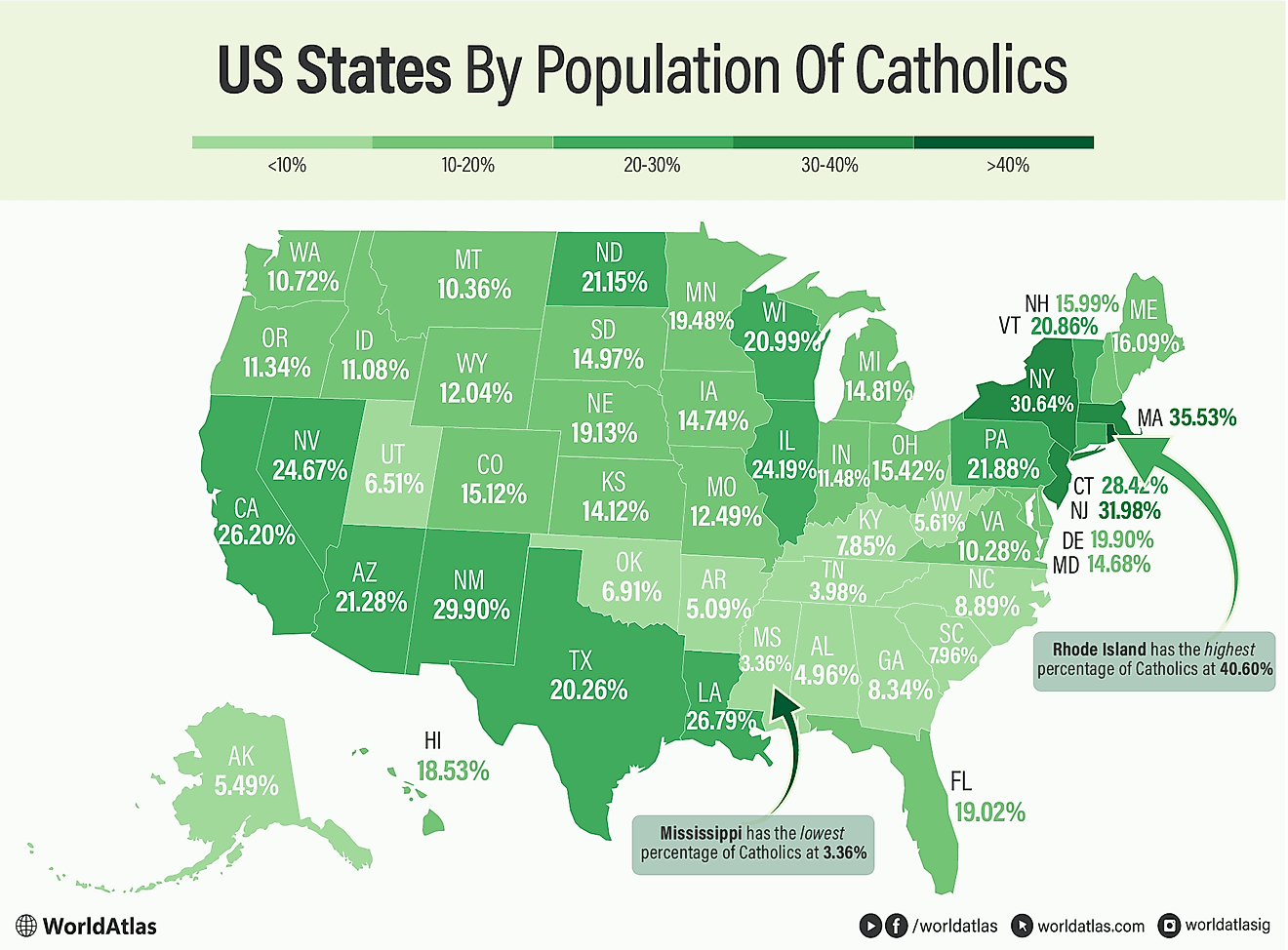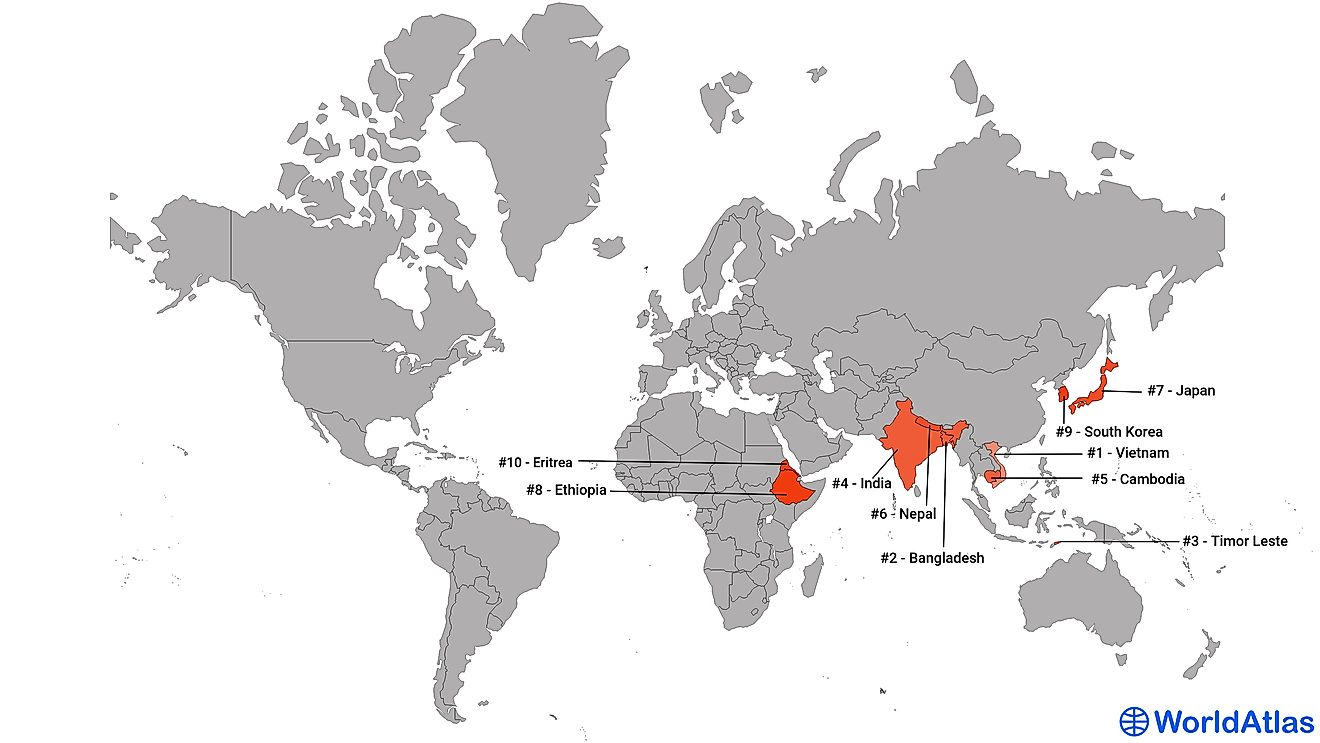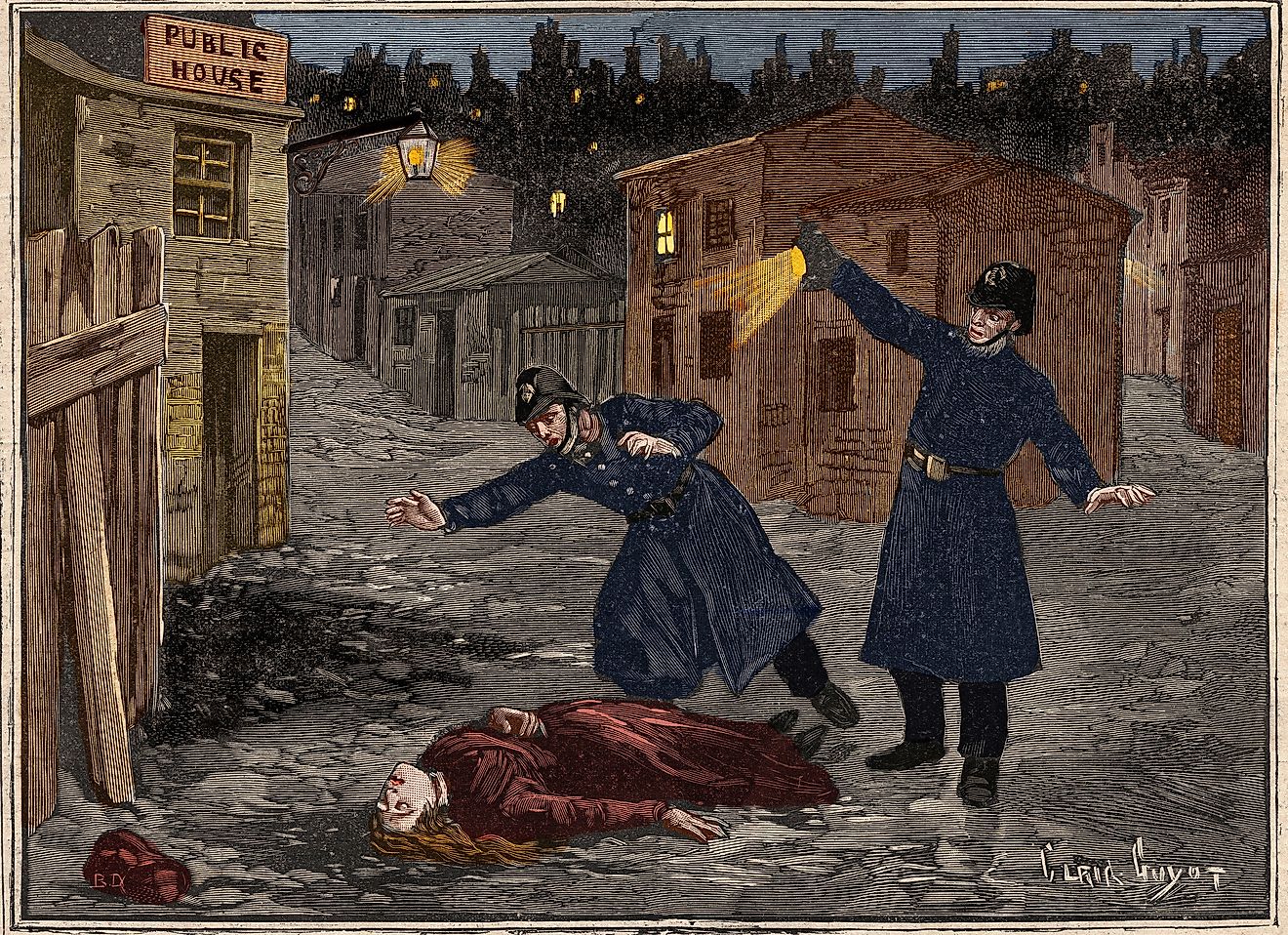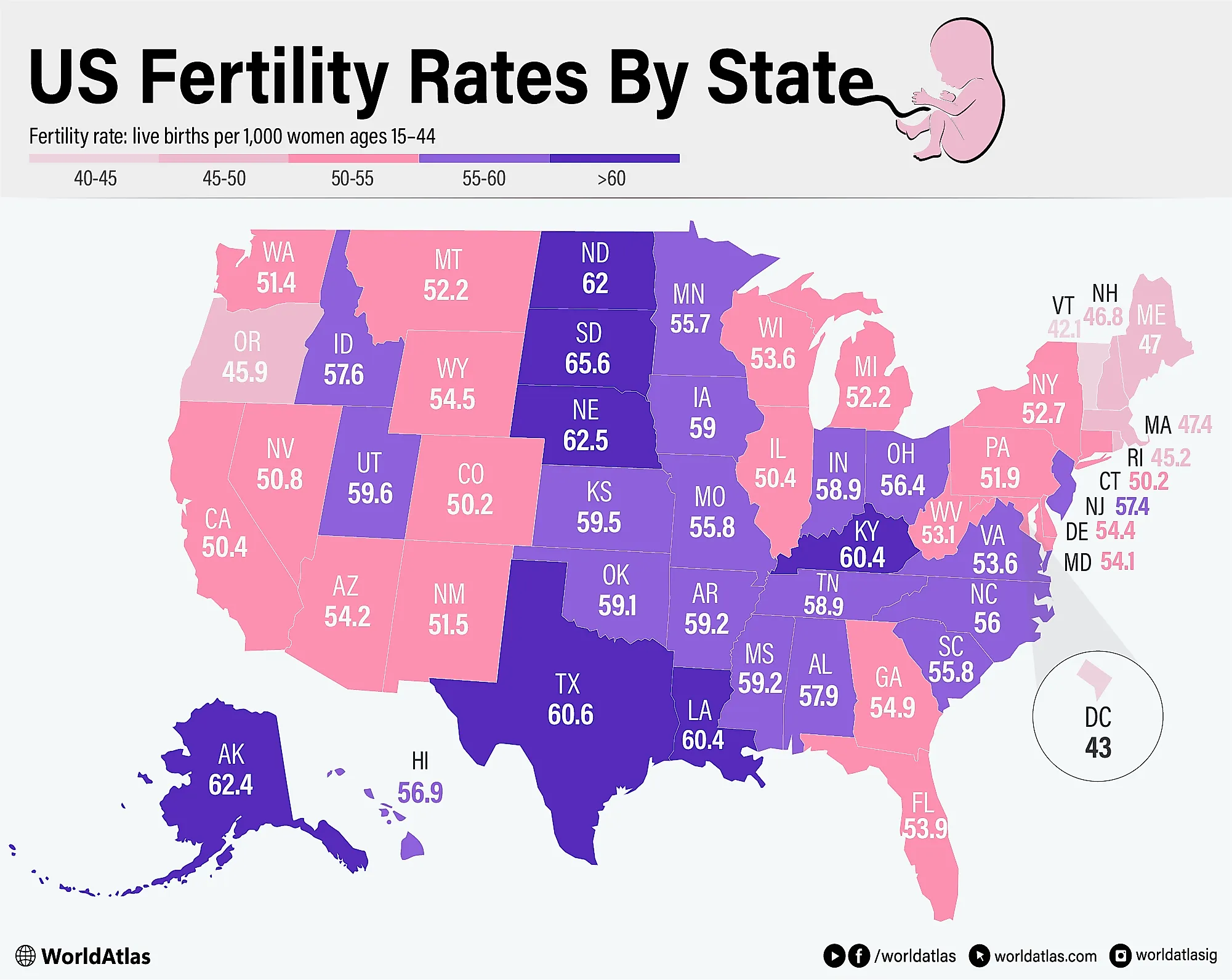
US States By Fertility Rate
Which states are still growing the old-fashioned way, through births? This ranking utilizes the general fertility rate, which is the number of births per 1,000 women aged 15-44. Unlike the total fertility rate (an estimate of lifetime births), this metric captures the current tempo of childbearing. It is highly sensitive to age structure, marriage patterns, cultural norms, immigration, and economic affordability.
Why should you care? Fertility shapes tomorrow's school enrollments, housing demand, labor supply, and state tax bases. States with youthful populations, family-centered cultures, and lower costs of living tend to score higher; places with older populations, high housing costs, or delayed marriage tend to score lower. High fertility isn't inherently "good" nor low fertility "bad"; migration can offset low birth rates, and teen births can inflate them. However, changes in fertility are early indicators of more profound social and economic shifts.
High fertility clusters in the Plains and parts of the Mountain West, think wide-open metros, lower costs, and strong family norms, with South Dakota, Nebraska, North Dakota, Utah, and Kansas prominent; Alaska also ranks high, and Southern states like Texas, Kentucky, Louisiana, and Arkansas round out the top tier.
10 US States With The Highest Fertility Rates
| Rank | State | Fertility Rate |
|---|---|---|
| 1 | South Dakota | 65.6 |
| 2 | Nebraska | 62.5 |
| 3 | Alaska | 62.4 |
| 4 | North Dakota | 62 |
| 5 | Texas | 60.6 |
| 6 | Kentucky* | 60.4 |
| 6 | Louisiana* | 60.4 |
| 7 | Utah | 59.6 |
| 8 | Kansas | 59.5 |
| 9 | Arkansas | 59.2 |
* Kentucky and Louisiana are tied at number 6.
Jump to the list of all US states ranked by fertility rates.
South Dakota - 65.6

South Dakota ranks first in U.S. fertility rates, with 65.6 births per 1,000 women aged 15-44. A landlocked state in the northern Great Plains, it is defined by its rural character, agricultural heritage, and Native American history, home to nine Sioux reservations. The state is split by the Missouri River into East River, known for farming, and West River, known for ranching, tourism, and the Black Hills. Major cities include Sioux Falls and Rapid City. South Dakota has a low population density and no state income tax, attracting both families and financial institutions. Its economy is diverse, with strengths in agriculture, finance, and tourism. Major attractions include Mount Rushmore, Badlands National Park, and the annual Sturgis Motorcycle Rally. Despite its conservative politics, the state has pockets of diversity, particularly in Native communities.
Nebraska - 62.5

Nebraska ranks second in the nation for fertility, with 62.5 births per 1,000 women aged 15-44. A landlocked Midwestern state, Nebraska is known for its vast plains, agricultural output, and low population density. Its largest city, Omaha, and capital, Lincoln, anchor the eastern half of the state, while western Nebraska is defined by wide-open prairie and the Sandhills region. Nebraska's economy centers on farming, ranching, freight, insurance, and food processing, with top crops including corn and soybeans. Home to a unicameral, nonpartisan legislature, the only one of its kind in the U.S., the state has a strong tradition of civic independence. Nebraska has a growing diversity, with a significant Hispanic population and one of the highest refugee resettlement rates per capita. Cultural roots run deep, from Native American history to Czech and German immigrant communities.
Alaska - 62.4

Alaska ranks third nationally in fertility, with a rate of 62.4 births per 1,000 women aged 15-44. As the largest and most sparsely populated U.S. state, Alaska is defined by its remote geography, rich Indigenous cultures, and frontier spirit. Most of the population resides in Anchorage, Fairbanks, and Juneau, while the Matanuska-Susitna Borough, home to growing towns like Wasilla and Palmer, is among the fastest-growing regions in the country. Alaska has one of the nation's highest proportions of Native American and Alaska Native residents, particularly in western and northern regions. Birth data shows steady contributions from White, Native, and Hispanic populations, with fertility supported by a youthful demographic profile. Culturally, the state reflects a blend of Indigenous, Russian, and Western traditions, and is home to 22 Indigenous languages.
North Dakota - 62

North Dakota ranks fourth in the U.S. for fertility, with a rate of 62.0 births per 1,000 women aged 15-44. A rural, agriculturally rich state in the Upper Midwest, it has a population just under 800,000 and one of the lowest population densities in the country. Its largest city, Fargo, and capital, Bismarck, anchor a state otherwise defined by vast plains, oil-rich badlands, and farmland. Historically home to Native tribes such as the Mandan, Hidatsa, and Sioux, it later attracted waves of German, Scandinavian, and Russian immigrants. In the 21st century, population growth has been driven by the oil boom in the Bakken region, along with consistently high birth rates, especially among Indigenous and refugee populations. The state has a unique economic profile, with a state-run bank and flour mill, and one of the lowest unemployment rates in the country.
Texas - 60.6

Texas ranks fifth nationally in fertility rate, driven in part by its large, diverse, and fast-growing population. With over 31 million residents in 2024, Texas is the second most populous state in the U.S., featuring a youthful demographic and one of the highest shares of Hispanic and Latino populations, communities with historically higher birth rates. Nearly 40% of Texans are of Hispanic descent, and over half of all births in the state are to Hispanic mothers. Texas also has a relatively high rate of teen births and a large immigrant population, further contributing to its birth rate. Major metro areas like Houston and Dallas-Fort Worth continue to expand rapidly, creating urban centers with high family formation rates.
Kentucky (tie) - 60.4

Kentucky ties for sixth place in U.S. fertility rates, with 60.4 births per 1,000 women aged 15-44. Known as the Bluegrass State, Kentucky blends Appalachian heritage, Southern traditions, and rural lifestyles across its 120 counties. While Louisville and Lexington anchor urban life, much of the population resides in small towns and agricultural communities. Kentucky's fertility rate is supported by a relatively high proportion of rural families, conservative cultural values, and a historically younger demographic. The state's population of 4.6 million has grown modestly in recent decades, driven more by natural increase than migration. Socioeconomic factors like lower cost of living and strong religious influence also contribute to larger family sizes. Kentucky's identity is closely tied to horse racing, bourbon production, and college basketball, but its economy is increasingly diverse, spanning agriculture, auto manufacturing, and healthcare.
Louisiana (tie) - 60.4

Louisiana ties for sixth in U.S. fertility rates, with 60.4 births per 1,000 women aged 15-44. A Deep South state shaped by French, Spanish, African, and Native American cultures, Louisiana is renowned for its distinctive heritage, multilingual population, and vibrant cities like New Orleans and Baton Rouge. The state's population of 4.6 million is racially diverse, with one of the highest shares of African American residents in the country. High birth rates are partly driven by a youthful demographic, strong cultural ties to religion and family, and above-average proportions of births to unmarried women. Louisiana's economy is anchored in energy, agriculture, and port trade, while its rural areas face persistent poverty and health disparities. Despite challenges, its cultural richness, from Cajun and Creole traditions to music and cuisine, remains nationally iconic.
Utah - 59.6

Utah ranks seventh in U.S. fertility, with 59.6 births per 1,000 women aged 15-44. Long known for having the highest fertility rate in the country, Utah's ranking has declined slightly in recent years, but its birth rate remains among the nation's highest. This is largely driven by cultural and religious factors: over half the population belongs to The Church of Jesus Christ of Latter-day Saints, which emphasizes family life and larger households. Utah also has the youngest median age of any U.S. state and one of the lowest rates of births to unmarried women. The state's population has grown rapidly, especially in the Wasatch Front and Washington County. Utah has a strong economy, high median income, and a family-friendly social climate, contributing to a high quality of life and sustained population growth.
Kansas - 59.5
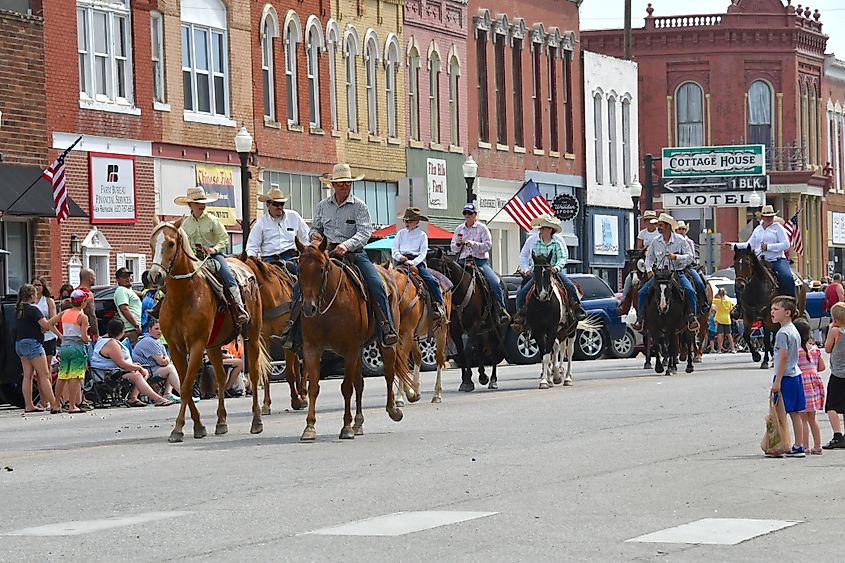
Kansas ranks eighth in U.S. fertility rates, with 59.5 births per 1,000 women aged 15-44. A heartland state known for its agricultural strength and geographic centrality, Kansas combines rural tradition with growing suburban centers. The state's fertility rate is influenced by its high share of married-couple households, strong religious culture, and sizable Hispanic population; nearly 18% of births in 2022 were to Hispanic mothers. Kansas has historically seen stable natural population growth despite net domestic out-migration. Fertility trends are particularly strong in rural western counties and expanding suburban regions around Kansas City and Wichita. While much of rural Kansas faces population decline, urban and suburban areas continue to grow. Culturally conservative values, family-friendly policies, and affordable living support larger families compared to national averages. As both a major wheat producer and home to aerospace hubs, Kansas reflects the broader demographic patterns of the Midwest, balancing urbanization with deeply rooted rural family traditions.
Arkansas - 59.2

Arkansas ties for ninth place in U.S. fertility rates, with 59.2 births per 1,000 women aged 15-44. A Southern state with a blend of mountainous highlands and fertile delta lowlands, Arkansas has a population of just over 3 million. Its fertility rate is bolstered by a relatively young population, strong religious influence, and a high share of births to unmarried women. The state's demographics are racially diverse, with a significant Black population concentrated in the Mississippi Delta, and growing Hispanic communities across the state. Little Rock, Fayetteville, and Bentonville are cultural and economic hubs, while rural regions still reflect traditional family structures and values. Arkansas's economy is driven by agriculture (including rice, poultry, and cotton), manufacturing, and retail, headlined by Walmart's global headquarters. Though long associated with high poverty and health disparities, the state remains family-oriented and culturally conservative, factors that have helped sustain one of the nation's higher fertility rates.
Taken together, these rankings are a snapshot, not a verdict. Using the general fertility rate (births per 1,000 women ages 15-44), they flag places where age structure, culture, costs, and migration intersect. High-fertility states may face near-term pressure on schools and housing; low-fertility states may lean more on in-migration for growth. Track these numbers over time; they're early signals of deeper economic, cultural, and policy shifts shaping the next generation ahead.
US States Ranked By Fertility Rates
| Rank | State | Fertility Rate |
|---|---|---|
| 1 | South Dakota | 65.6 |
| 2 | Nebraska | 62.5 |
| 3 | Alaska | 62.4 |
| 4 | North Dakota | 62 |
| 5 | Texas | 60.6 |
| 6 | Kentucky* | 60.4 |
| 6 | Louisiana* | 60.4 |
| 7 | Utah | 59.6 |
| 8 | Kansas | 59.5 |
| 9 | Arkansas* | 59.2 |
| 9 | Mississippi* | 59.2 |
| 10 | Oklahoma | 59.1 |
| 11 | Iowa | 59 |
| 12 | Indiana* | 58.9 |
| 12 | Tennessee* | 58.9 |
| 13 | Alabama | 57.9 |
| 14 | Idaho | 57.6 |
| 15 | New Jersey | 57.4 |
| 16 | Hawaii | 56.9 |
| 17 | Ohio | 56.4 |
| 18 | North Carolina | 56 |
| 19 | Missouri* | 55.8 |
| 19 | South Carolina* | 55.8 |
| 20 | Minnesota | 55.7 |
| 21 | Georgia | 54.9 |
| 22 | Wyoming | 54.5 |
| 23 | Delaware | 54.4 |
| 24 | Arizona | 54.2 |
| 25 | Maryland | 54.1 |
| 26 | Florida | 53.9 |
| 27 | Virginia* | 53.6 |
| 27 | Wisconsin* | 53.6 |
| 28 | West Virginia | 53.1 |
| 29 | New York | 52.7 |
| 30 | Michigan* | 52.2 |
| 30 | Montana* | 52.2 |
| 31 | Pennsylvania | 51.9 |
| 32 | New Mexico | 51.5 |
| 33 | Washington | 51.4 |
| 34 | Nevada | 50.8 |
| 35 | California* | 50.4 |
| 35 | Illinois* | 50.4 |
| 36 | Colorado* | 50.2 |
| 36 | Connecticut* | 50.2 |
| 37 | Massachusetts | 47.4 |
| 38 | Maine | 47 |
| 39 | New Hampshire | 46.8 |
| 40 | Oregon | 45.9 |
| 41 | Rhode Island | 45.2 |
| - | District of Columbia | 43 |
| 42 | Vermont | 42.1 |
* The list has several ties: 60.4: Kentucky & Louisiana; 59.2: Arkansas & Mississippi; 58.9: Indiana & Tennessee; 55.8: Missouri & South Carolina; 53.6: Virginia & Wisconsin; 52.2: Michigan & Montana; 50.4: California & Illinois; 50.2: Colorado & Connecticut.

